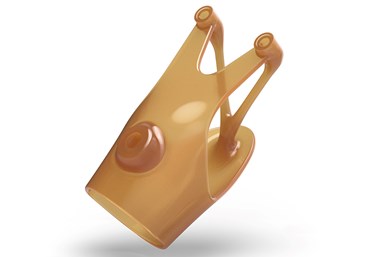3D Systems’ Accura AMX Resin Withstands Harsh Thermal Environments
Formnext 2023: The resin material is well suited for the testing of high-temperature components in applications such as HVAC, consumer appliances, motor enclosures, fixtures, mounts, stators, molding/tooling and more.
3D Systems’ Accura AMX High Temp 300C is an unfilled ultrahigh-temperature SLA resin that does not require a post thermal cure and is the engineered to meet the demands of applications requiring a HDT up to 300°C. Photo Credit: 3D Systems
3D Systems’ Accura AMX High-Temp 300C, is an ultrahigh-temperature stereolithography (SLA) resin that is engineered to meet the demands of applications requiring the highest levels of heat resistance. It is a print production-grade, highly thermal-resistant, translucent plastic for elevated temperature fluid or flow visualization.
The ultrahigh-temperature-resistant rigid plastic material is engineered to withstand the harshest thermal environments. The company says it is the industry’s most heat-resistant SLA material with a heat-deflection temperature (HDT) of over 300 °C at low stress (at 0.455 MPa) that does not require a post thermal cure.
This material is well suited for the testing of high-temperature components in applications such as HVAC, consumer appliances, motor enclosures, fixtures, mounts, stators, molding/tooling and many others.
Applications include high-temperature components testing and general-use parts, as well as low-pressure molding/tooling such as expanding foams and rubbers. It can also be used for functional prototype and production components for fixtures, mounts, housings, white goods and personal care products. It is also well suited for elevated-temperature fluid or gas flow visualization, and overmolding.
The resin also offers advantages such as a shortened production workflow and no requirement for a post thermal cure. It also provides excellent visualization for parts requiring evaluation of internal features and fluid flow performance; and chemical and auto fluid compatibility.
The resin also boasts isotropic properties. The SLA technology prints parts that are generally isotropic in mechanical properties, meaning the parts printed along either the XYZ axis will give similar results. Parts do not need to be oriented to get the highest mechanical properties, further improving the degree of freedom for part orientation for mechanical properties.
- Learn about 3D Systems verifying the performance of NASA’s GRX-810 Super Alloy. This oxide dispersion-strengthened alloy, developed by NASA, demonstrates exceptional mechanical properties and resistance to extreme temperatures, making it well suited for future use in critical components such as rocket engines, turbine blades and exhaust nozzle components.
- Read about 3D Systems developing materials and printer platform for improved digital dentistry. 3D Systems is strengthening its digital dentistry portfolio with new materials, NextDent Base and NextDent Cast, and a new printing platform, the NextDent LCD1.
Related Content
-
3D Systems’ PSLA 270 Creates Midsize, Production-Grade Parts Combining SLA Print Reliability
IMTS 2024: The PSLA 270 is engineered to deliver larger end-use parts more rapidly than similar platforms, bringing tremendous advantages for a breadth of industrial and health care applications.
-
Q&A With Align EVP: Why the Invisalign Manufacturer Acquired Cubicure, and the Future of Personalized Orthodontics
Align Technology produces nearly 1 million unique aligner parts per day. Its acquisition of technology supplier Cubicure in January supports demand for 3D printed tooling and direct printed orthodontic devices at mass scale.
-
7 Takeaways on 3D Printing As a Pathway to Polymer’s Future
The Cleveland section of SPE hosted “Additive Manufacturing: Printing the Path for the Future” on October 17, 2024. Speakers signaled where AM is and where it is headed with session topics ranging from pellet-based 3D printing to qualification and commercialization of additively manufactured products.















